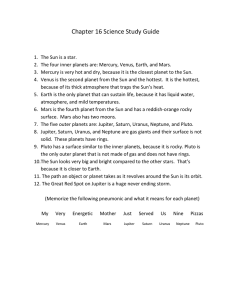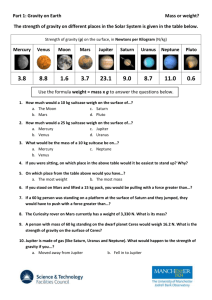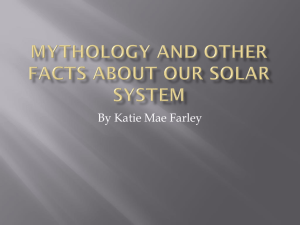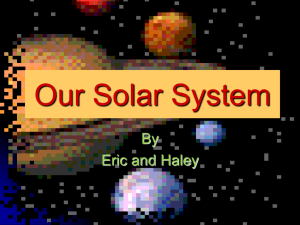Solar System
advertisement
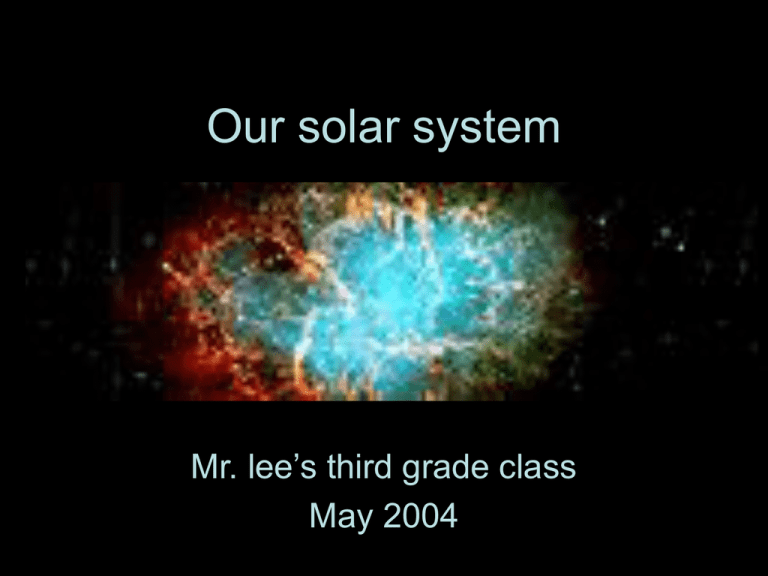
Our solar system Mr. lee’s third grade class May 2004 Mercury By Brett, Rebecca, Cody Solar System • The planet Mercury is located in the Solar System. How Far It Is From The Sun Mercury • Mercury is the the closest planet to the sun. • This planet is 27 million miles away from the sun and also 70 million kilometers away. The Size Of Mercury • Mercury is 3.3 x 1023kg and 3,031 miles in diameter Diameter • The diameter of Mercury in miles is 3,031. • Also the diameter in kilometers is 4,878. Mass • 3.3 x 10 23 Mantle • Silicate rocks Crust • Silicate rocks Mercury Weather The atmosphere is filled with hydrogen and helium. Length of day The length of day is 1407.6 hours Also the length of year is 88 earth days. Amazing Fact An amazing fact about Mercury is ; it actually has a very thin atmosphere consisting of atoms blasted of its surface by solar wind. Because Mercury is so hot,these atoms quickly escaped into space Venus Project By Chandler,Roman,Jeanne Venus Gravity • Gravity 0.91 Mass of Venus This is Venuses mass. Number of rings/satellites Venus has no rings or satellites. VENUS Weather Features • Sulfuric acid & Carbon dioxide Venus • This is Venus Orbital periods of Venus This is Venuses orbital periods. Inside Venus This is the inside of Venus. Venus Satellite Trips Green House Effect • This is why Venus is the hottest planet. The core of Venus The inner core is nickel-iron.The rest is silicate rock. Venus Map This is a map of Venus. Pictures of Venus Where are We? hello Mother Earth and what she is made of Solar System earth Third rock from the sun Where is earth? sun Earth The distance between the sun and earth is an average of 93,000,000 Miles Now that we know where and how big… The earth is made of many different layers. These layers are made up of different materials and consistencies. The inner core is hotter than the surface of the sun! The earth is like a Jawbreaker. The Layers of the Earth Up to 40 km 0-870º c Up to 650 km Up to 2,700-2890 km 3,700º c Up to 5,150 km 4,300º c 7,200º C Up to 6,378 km Atmosphere The earth’s atmosphere is made up of many different levels. The bottom of this chart is the surface of the earth. The top of this chart is where space begins. Notice how “close” to the earth all of our weather happens Weather From water Weather from clouds Hurricanes QuickTime™ and a Cinepak decompressor are needed to see this picture. Tornados Weather from wind A’Aziziyah, Libya, Africa 135.9º F 9/13/22 Death Valley, California, USA 134º F 7/10/13 Vostock II, Antarctica -128.6º F 7/21/83 Prospect Creek, Alaska, USA 80ºF 1/23/71 Weather from ice and snow Earth’s Orbital period It actually takes the earth 365 days, 6 hours, 9 minutes, And 9.5 seconds to orbit (travel around An object from one point and Back to that same point) the sun. Ever wonder why we have leap years? The 6 hours Makes 1/4 of a day - every 4 years! Earth’s axis Planet Earth spins Around On an imaginary pole Called an axis. This axis Is tilted at an angle of 23.45º. The time it takes The earth to spin around once is 23.93 hours or 23 hours and 56 minutes Size - comparison Size The earth has a diameter Of 7,926 miles or 12,756 Km A circumference Of 24,901.55 miles Or 40,075.16 KM The earth is the fifth (5th) planet in size. Earth’s mass The mass of the earth is 5.98 X 1024 kg, or 598,000,000,000,000, 000 ,000,000,000 kg! Can you believe this guy?!?! I mean he really thinks he can hold up Planet earth. Density - mass per unit of volume of a substance If Water’s density is 1,027kg/m3, and earth’s density is 5,520kg/m3, then the earth will sink if we had a jar big enough to hold the earth and enough water to test this fact. gravity Unlike the moon’s gravity of 17% of earth’s, earth actually has a gravity of 1. This means that if you have a 100lb. Person on the earth they will weigh 100lbs., On the moon they will only weigh 17lbs. Earth’s M O O Mass - 7.35X1022kg n A natural satellite 1/4 of earth’s size 17% of earth’s Gravity 3/5 of the Density of Earth We even know what is inside the moon. fascinating Earth, a t o Discover! place MARS BY SAVANNA & SHANE Spirit/Opportunity/Rover • Picture#1- Mars Rover is about to launch. • Picture#2- Mars Rover is launching. 10-9-8-7-6-5-4-3-2-1-0 BLAST OFF • That Rover Is GONE To Mars !!!! BYE-BYE EARTH !! • MARS OPPURTUNITY IS LEAVING FOR MARS Satellite dish gone wrong WE BLEW UP PART OF MARS KIDS NEXT DOOR SATEIIITE DEIMOS • DEIMOS IS ONE OF THE MOONS ON MARS. • THE NAME DEIMOS MEANS TERROR. TEMPERATURE HIGH:168ºF LOW : -220ºF PHOBOS • PHOBOS IS ONE OF THE MOONS ON MARS. • THE NAME PHOBOS MEANS FEAR. FACE • MARS HAS A FACE!!! Mars water • Believe it or not Mars has water. MARS MASS • MARS HAS 11% OF EARTH’S MASS • IT WOULD TAKE 9 MARS TO EQUAL THE MASS OF THE EARTH. SPIRIT ROVER MOVIE QuickTime™ and a Sorenson Video decompressor are needed to see this picture. THE END Jupiter Wyatt Parks, Whitney Mitchell, Stefan Desimone Mr.. Lee B-3 Size of Jupiter and the Earth • The Earth would fit in Jupiter’s big red spot. • Jupiter is bigger than Earth. Interesting Facts • Jupiter has crystalline ammonia clouds • The gravity is 2.6 • If Jupiter gets cold it might snow. Weather Features • The weather and rainy. features on Jupiter are sunny Jupiter’s Temperature • Jupiter’s high temperature is 230. • Jupiter’s lowest temperature is 130. Length of day and year • A day on Jupiter is 11.68 years. • An hour is 9.8 on Jupiter This is the end of our Presentation Planet Order Mercury, Venus, Earth, Mars, Jupiter, Saturn, Uranus, Neptune, Pluto. Jupiter’s Rings • Jupiter has 3 little rings Structure • Innercore:silicate rock,ice • Outercore:liquid metallic hydrogen • Mantle:liquid molecular hydrogen • Crust:hydrogen,heliu m, with crystaline ammonia clouds Size • The diameter of Jupiter is 88,700 miles 142,800 kilometers. • The mass is about 318 Earths. Moons Metis,Adrastea,Amathea,Thebe,Io,Europa,Ganymede,Callisto, Leda,Himalaia,Lysithea,Elara,Ananke,Carme,Pasiphae,Sinope, S/1999 J1. Saturn By,Ethan,Hannah,and Clayton Where is Saturn? • Saturn is the 6th planet from the sun Mass It’s mass is 5.68 26 kg Saturn’s diameter •74,898 miles and •in km is 120,536 Saturn’s gravity •Saturn’s gravity is 0.8 x earths Gravity Distance from sun • 9,537,000 miles from sun and in km it is 12,672,540 Saturn’s orbital Period •26.7 is Saturn’s orbital period Saturn’s Average Temperature • Saturn’s average temperature is -290º F Weather Features • Saturn’s weather features are high winds Saturn’s Structure • The layered atmosphere is mostly hydrogen and helium • The outer core/mantle is Molecular Hydrogen • The inner core is liquid metallic hydrogen • The core is hot silicate rock, maybe solid Saturn’s Moons and Rings •The first picture is four views of Titan, a moon that is a mirror image of Earth. •The second picture is details of Saturn’s rings. Saturn’s Rotational Period •Saturn’s rotational period is 10.2 hours, relative to orbit. Uranus By Courtney,Logan,and Jalen Uranus Uranus is in the solar system,and it is the seventh planet away from the sun. Distance from the sun. The distance from the sun is 1,850,000,000 miles and 3,003,000,000 km. Orbital period of Uranus. The orbital period (in earth days) is 84.07. Uranus’ rotational period QuickTime™ and a TIFF (Uncompressed) decompressor are needed to see this picture. Uranus’ rotational period in earth hours is 17.9. Uranus’ days are shorter than our days their days are only 17.9 hours. Uranus’ days our shorter than ours by 6.1 hours. The diameter of Uranus in miles and km. The diameter of Uranus is 31,690 miles and 51,118 km . Uranus’ temperature Uranus’ low temperature is -350 degrees. Uranus is so cold that they don’t have heat. Uranus' weather features Uranus’ weather features are 83%hydrogen 15%helium and 2%methane. Uranus is mostly made of hydrogen. Uranus’ Mass Uranus’ mass is 25 8.68x10 kg. Uranus’ gravity Uranus’ gravity is 91%. Uranus’ structure Uranus’ structure is Core:molten rock Mantle:icy water,ammonia Methane Crust:liquid hydrogen. Number of rings and satellites Uranus has 11 rings. Uranus has 22 satellites. Uranus has 21 more satellites than us. Uranus’ satellites’ names Cordelia,Ophelia, Bianca,Cressida, Desdemona,Juliet Portian,Rosalid,Belinda, 1986u10,Puck,Miranda, . Ariel,Umbiel,Titania, Oberon,Caliban ,Sycorax Uranus’ satellites structures Miranda 130,000 Ariel191,000 Umbiel266,000 Titania436,000 Oberon583,000. Neptune Neptune’s moons Neptune has 8 moons. Neptune’s weather Neptune has icy gas and a huge storm with winds that go up to 1,500 mph. Neptune’s place Neptune is the 8th planet. Temperature Neptune’s temperature is 48K 212ºf=373.15ºk 32ºf=273.15ºk Neptune’s orbit The orbit is 4,456,000,000 KM from the sun. It 164.8 Earth years to go around the sun. The dark spot Phases of Neptune The mass 1 Neptune = 60 Earths Neptune’s mass is 17.14 times Earth’s mass Symbol of Neptune symbol of Neptune named after the The god of the sea fourth planet Asteroids from Neptune Most of the moons from Neptune are asteroids capered in the gravity of Neptune. asteroids Pluto is our planet. 1 School day 1 day of school on Pluto is 50.955 earth hours long! 1 Day on Pluto 1 day on Pluto is 89,955 days on earth. MILES FROM THE SUN Pluto is 2.8 billion miles from the sun . Pluto is 5,913,520kg. From the sun. 1year on Pluto 1 year on Pluto is 248 earth years. The cores of Pluto Pluto is made of water ice, carbon-dioxide methane,nitrogen. Pluto’s mass • The mass of Pluto is 1.29x1022 kg. The gravity of Pluto. The gravity of Pluto is 8% gravity on earth. The temperature of Pluto. The high is -396 degrees Fahrenheit and the other high temperature is -378.And the low temperatures are -378 and -228 degrees Fahrenheit. Pluto’s weather features. Pluto’s weather features are Nitrogen and carbonmonoxide. Pluto’s moons. Pluto has one moon. The name of that moon is Charon. That moon is made out of water ice.
